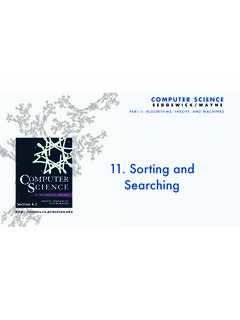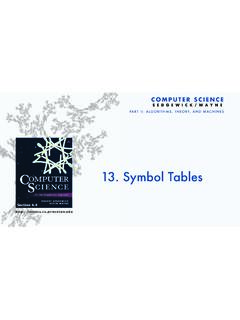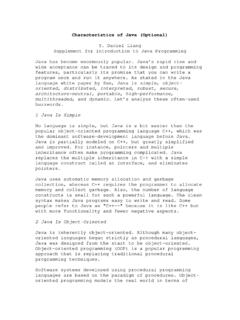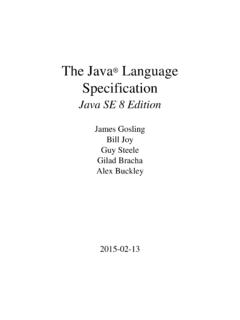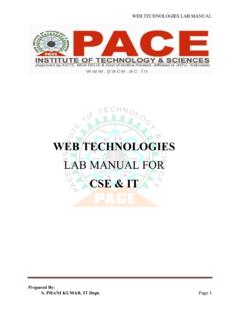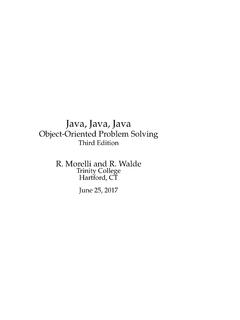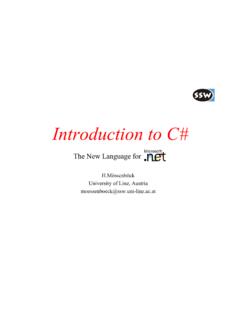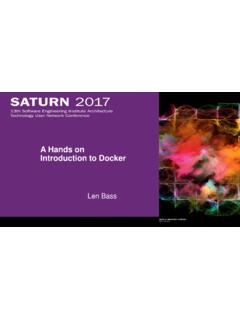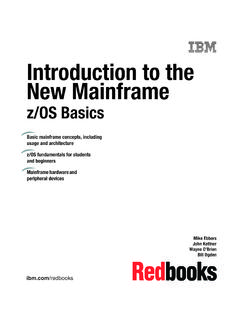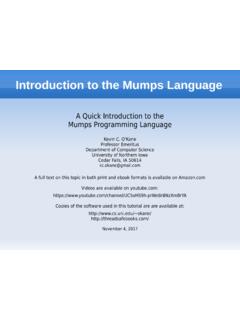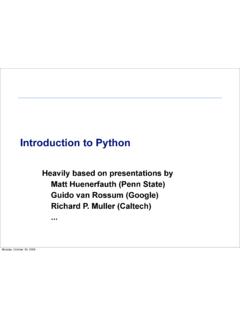Transcription of Introduction to Programming in Java
1 IntroductiontoProgramming in JavaAn Interdisciplinary ApproachRobert SedgewickandKevin WaynePrinceton UniversityO N L I N E P R E V I E W!"#$%&'(')!"*+,,, ,,,0425,67 Publisher Greg TobinExecutive Editor Michael HirschAssociate Editor Lindsey TriebelAssociate Managing Editor Jeffrey HolcombSenior Designer Joyce Cosentino WellsDigital Assets Manager Marianne GrothSenior Media Producer Bethany TiddSenior Marketing Manager Michelle BrownMarketing Assistant Sarah MilmoreSenior Author Support/ Technology Specialist Joe VetereSenior Manufacturing Buyer Carol MelvilleCopyeditor Genevieve d EntremontComposition and Illustrations Robert Sedgewick and Kevin
2 WayneCover Image: Robert Sedgewick and Kevin WaynePage 353 2006 C. Herscovici, Brussels / Artists Rights Society (ARS), New York Banque d Images, ADAGP / Art Resource, NYMany of the designations used by manufacturers and sellers to distinguish their products are claimed as trade-marks. Where those designations appear in this book, and Addison-Wesley was aware of a trademark claim, the designations have been printed in initial caps or all interior of this book was composed in Adobe of Congress Cataloging-in-Publication DataSedgewick, Robert, 1946- Introduction to Programming in java : an interdisciplinary approach / by Robert Sedgewick and Kevin Wayne.
3 P. cm. Includes index. ISBN 978-0-321-49805-2 (alk. paper) 1. java (Computer program language) 2. Computer Programming . I. Wayne, Kevin Daniel, 1971- II. Title. 2007 3--dc22 2007020235 Copyright 2008 Pearson Education, Inc. All rights reserved. No part of this publication may be reproduced, stored in a retrieval system, or transmitted, in any form or by any means, electronic, mechanical, photocopying, recording, or otherwise, without the prior written permission of the publisher.
4 Printed in the United States of America. For information on obtaining permission for use of material in this work, please submit a written request to Pearson Education, Inc., Rights and Contracts Department, 501 Boylston Street, Suite 900, Boston, MA 02116, fax (617) 671-3447, or online at : 978-0-321-49805-2 ISBN-10: 0-321-49805-41 2 3 4 5 6 7 8 9 10 CRW 11 10 09 08 07!"#$%&'(')!"*+,,, ,,,0425,67vPrefaceTHE BASIS FOR EDUCATION IN THE last millennium was reading, writing, and arith-metic; now it is reading, writing, and computing.
5 Learning to program is an essential part of the education of every student in the sciences and engineering. Beyond direct applications, it is the first step in understanding the nature of com-puter science s undeniable impact on the modern world. This book aims to teach Programming to those who need or want to learn it, in a scientific primary goal is to empower students by supplying the experience and basic tools necessary to use computation effectively. Our approach is to teach stu-dents that writing a program is a natural, satisfying, and creative experience (not an onerous task reserved for experts).
6 We progressively introduce essential con-cepts, embrace classic applications from applied mathematics and the sciences to illustrate the concepts, and provide opportunities for students to write programs to solve engaging use the java Programming language for all of the programs in this book we refer to java after Programming in the title to emphasize the idea that the book is about fundamental concepts in Programming , not java per se. This book teaches basic skills for computational problem-solving that are applicable in many modern computing environments, and is a self-contained treatment intended for people with no previous experience in Programming .
7 This book is an interdisciplinary approach to the traditional CS1 curriculum, where we highlight the role of computing in other disciplines, from materials sci-ence to genomics to astrophysics to network systems. This approach emphasizes for students the essential idea that mathematics, science, engineering, and com-puting are intertwined in the modern world. While it is a CS1 textbook designed for any first-year college student interested in mathematics, science, or engineer-ing (including computer science), the book also can be used for self-study or as a supplement in a course that integrates Programming with another field.
8 !"#$%&'(')!"*+,,, ,,,0425,67viCoverage The book is organized around four stages of learning to program: ba-sic elements, functions, object-oriented Programming , and algorithms (with data structures). We provide the basic information readers need to build confidence in writing programs at each level before moving to the next level. An essential feature of our approach is to use example programs that solve intriguing problems, sup-ported with exercises ranging from self-study drills to challenging problems that call for creative solutions.
9 Basic elements include variables, assignment statements, built-in types of data, flow of control (conditionals and loops), arrays, and input/output, including graphics and and modules are the student s first exposure to modular program-ming. We build upon familiarity with mathematical functions to introduce java static methods, and then consider the implications of Programming with func-tions, including libraries of functions and recursion. We stress the fundamental idea of dividing a program into components that can be independently debugged, maintained, and reused.
10 Object-oriented Programming is our Introduction to data abstraction. We em-phasize the concepts of a data type (a set of values and a set of operations on them) and an object (an entity that holds a data-type value) and their implementation using java s class mechanism. We teach students how to use, create, and design data types. Modularity, encapsulation, and other modern Programming paradigms are the central concepts of this and data structures combine these modern Programming para-digms with classic methods of organizing and processing data that remain effec-tive for modern applications.
